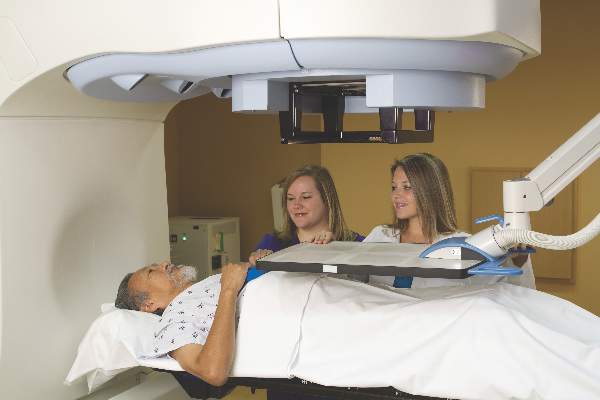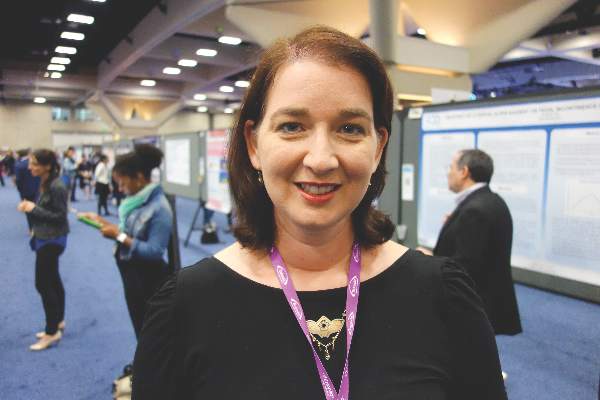User login
Cabozantinib improves overall survival in renal cell carcinoma
CHICAGO – The oral multitargeted tyrosine kinase inhibitor cabozantinib confers an overall survival benefit to patients with previously treated renal cell carcinoma, compared with everolimus, according to the final survival analysis of the phase III METEOR trial.
An analysis of the 658 patients enrolled in the study revealed that “treatment with cabozantinib significantly improved overall survival, compared to everolimus. The median overall survival was 21.4 months in the cabozantinib group, compared to 16.5 months in the everolimus group,” Toni Choueiri, M.D., of the Dana-Farber Cancer Institute in Boston reported at the annual meeting of the American Society of Clinical Oncology.
”The hazard ratio of 0.66 does represent a 34% reduction in the rate of deaths,” he said.
An overall survival benefit associated with cabozantinib was consistently observed in all prespecified groups including the groups stratified by Memorial Sloan Kettering Cancer Center (MSKCC) risk criteria, the number and duration of prior vascular endothelial growth factor receptor tyrosine kinase inhibitor therapies, and tumor MET status.
An analysis of the same 658 patients enrolled in the METEOR trial, presented at the Genitourinary Cancers Symposium in early 2016, indicated cabozantinib improved progression-free survival, compared with everolimus (7.4 months vs. 3.9 months, HR, 0.52; P less than .001).
Cabozantinib is the only agent to demonstrate a significant benefit in overall survival, progression-free survival, and overall response rate in a phase III trial in previously treated patients with advanced renal cell carcinoma, according to Dr. Choueiri. “Cabozantinib is an important new treatment option for these patients,” he said.
This study was funded by Exelixis. Dr. Choueiri reported serving in advisory roles and receiving research funding and honoraria from multiple companies.
On Twitter @jessicolecraig
CHICAGO – The oral multitargeted tyrosine kinase inhibitor cabozantinib confers an overall survival benefit to patients with previously treated renal cell carcinoma, compared with everolimus, according to the final survival analysis of the phase III METEOR trial.
An analysis of the 658 patients enrolled in the study revealed that “treatment with cabozantinib significantly improved overall survival, compared to everolimus. The median overall survival was 21.4 months in the cabozantinib group, compared to 16.5 months in the everolimus group,” Toni Choueiri, M.D., of the Dana-Farber Cancer Institute in Boston reported at the annual meeting of the American Society of Clinical Oncology.
”The hazard ratio of 0.66 does represent a 34% reduction in the rate of deaths,” he said.
An overall survival benefit associated with cabozantinib was consistently observed in all prespecified groups including the groups stratified by Memorial Sloan Kettering Cancer Center (MSKCC) risk criteria, the number and duration of prior vascular endothelial growth factor receptor tyrosine kinase inhibitor therapies, and tumor MET status.
An analysis of the same 658 patients enrolled in the METEOR trial, presented at the Genitourinary Cancers Symposium in early 2016, indicated cabozantinib improved progression-free survival, compared with everolimus (7.4 months vs. 3.9 months, HR, 0.52; P less than .001).
Cabozantinib is the only agent to demonstrate a significant benefit in overall survival, progression-free survival, and overall response rate in a phase III trial in previously treated patients with advanced renal cell carcinoma, according to Dr. Choueiri. “Cabozantinib is an important new treatment option for these patients,” he said.
This study was funded by Exelixis. Dr. Choueiri reported serving in advisory roles and receiving research funding and honoraria from multiple companies.
On Twitter @jessicolecraig
CHICAGO – The oral multitargeted tyrosine kinase inhibitor cabozantinib confers an overall survival benefit to patients with previously treated renal cell carcinoma, compared with everolimus, according to the final survival analysis of the phase III METEOR trial.
An analysis of the 658 patients enrolled in the study revealed that “treatment with cabozantinib significantly improved overall survival, compared to everolimus. The median overall survival was 21.4 months in the cabozantinib group, compared to 16.5 months in the everolimus group,” Toni Choueiri, M.D., of the Dana-Farber Cancer Institute in Boston reported at the annual meeting of the American Society of Clinical Oncology.
”The hazard ratio of 0.66 does represent a 34% reduction in the rate of deaths,” he said.
An overall survival benefit associated with cabozantinib was consistently observed in all prespecified groups including the groups stratified by Memorial Sloan Kettering Cancer Center (MSKCC) risk criteria, the number and duration of prior vascular endothelial growth factor receptor tyrosine kinase inhibitor therapies, and tumor MET status.
An analysis of the same 658 patients enrolled in the METEOR trial, presented at the Genitourinary Cancers Symposium in early 2016, indicated cabozantinib improved progression-free survival, compared with everolimus (7.4 months vs. 3.9 months, HR, 0.52; P less than .001).
Cabozantinib is the only agent to demonstrate a significant benefit in overall survival, progression-free survival, and overall response rate in a phase III trial in previously treated patients with advanced renal cell carcinoma, according to Dr. Choueiri. “Cabozantinib is an important new treatment option for these patients,” he said.
This study was funded by Exelixis. Dr. Choueiri reported serving in advisory roles and receiving research funding and honoraria from multiple companies.
On Twitter @jessicolecraig
FROM 2016 ASCO ANNUAL MEETING
Key clinical point: Cabozantinib significantly improved overall survival, compared with everolimus in patients with renal cell carcinoma.
Major finding: For cabozantinib the median overall survival was 21.4 months, compared with 16.5 months in the everolimus group (HR, 0.66; 95% CI, 0.53-0.83; P = .0003).
Data source: A survival analysis of 658 patients with previously treated advanced renal cell carcinoma enrolled in the randomized phase III METEOR trial.
Disclosures: This study was funded by Exelixis. Dr. Choueiri reported serving in advisory roles and receiving research funding and honoraria from multiple companies.
SU2C announces researcher-industry collaboration on immunotherapy
Stand Up To Cancer is calling for proposals to investigate additional uses for nivolumab, ipilimumab, elotuzumab, and urelumab, as part of a new researcher-industry collaborative program.
As many as four projects will be funded by Bristol-Myers Squibb, maker of the four agents, in the range of $1 million to $3 million each, according to a written statement from the American Association for Cancer Research (AACR).
The company will provide access to the three drugs already approved for the treatement of various cancers –nivolumab, ipilimumab, and elotuzumab– and to urelumab, an investigational agent that is currently in early clinical trials.
Proposals can include the study of one or more of the products, alone or in combination with other treatments, and may include products from other companies, as well as explore potential new uses for the drug(s), AACR said in the statement.
Nivolumab (Opdivo) is currently approved to treat advanced melanoma, non-small cell lung cancer, renal cell carcinoma, and classical Hodgkin lymphoma; Ipilimumab (Yervoy) is approved to treat melanoma; and elotuzumab (Empliciti) is approved to treat multiple myeloma, in conjunction with other drugs. Urelumab is being evaluated as a treatment for a range of cancers, including some hematological cancers, advanced colorectal cancer, and head and neck cancers.
The Stand Up To Cancer (SU2C) Catalyst program was launched in April to “use funding and materials from the pharmaceutical, biotechnology, diagnostic, and medical devices industries to accelerate research on cancer prevention, detection, and treatment,” according to a written statement from SU2C. Founding collaborators in addition to Bristol-Myers Squibb include Merck and Genentech.
The Catalyst projects must follow the SU2C model be carried out by a collaborative team, and be designed to accelerate the clinical use of therapeutic agents within the 3-year term of the grant, and to deliver near-term patient benefit.
The Request for Proposal for the Bristol-Myers Squibb agents is available at proposalCENTRAL, with proposals due by noon ET Monday, Aug. 15.
lnikolaides@frontlinemedcom.com
On Twitter @NikolaidesLaura
Stand Up To Cancer is calling for proposals to investigate additional uses for nivolumab, ipilimumab, elotuzumab, and urelumab, as part of a new researcher-industry collaborative program.
As many as four projects will be funded by Bristol-Myers Squibb, maker of the four agents, in the range of $1 million to $3 million each, according to a written statement from the American Association for Cancer Research (AACR).
The company will provide access to the three drugs already approved for the treatement of various cancers –nivolumab, ipilimumab, and elotuzumab– and to urelumab, an investigational agent that is currently in early clinical trials.
Proposals can include the study of one or more of the products, alone or in combination with other treatments, and may include products from other companies, as well as explore potential new uses for the drug(s), AACR said in the statement.
Nivolumab (Opdivo) is currently approved to treat advanced melanoma, non-small cell lung cancer, renal cell carcinoma, and classical Hodgkin lymphoma; Ipilimumab (Yervoy) is approved to treat melanoma; and elotuzumab (Empliciti) is approved to treat multiple myeloma, in conjunction with other drugs. Urelumab is being evaluated as a treatment for a range of cancers, including some hematological cancers, advanced colorectal cancer, and head and neck cancers.
The Stand Up To Cancer (SU2C) Catalyst program was launched in April to “use funding and materials from the pharmaceutical, biotechnology, diagnostic, and medical devices industries to accelerate research on cancer prevention, detection, and treatment,” according to a written statement from SU2C. Founding collaborators in addition to Bristol-Myers Squibb include Merck and Genentech.
The Catalyst projects must follow the SU2C model be carried out by a collaborative team, and be designed to accelerate the clinical use of therapeutic agents within the 3-year term of the grant, and to deliver near-term patient benefit.
The Request for Proposal for the Bristol-Myers Squibb agents is available at proposalCENTRAL, with proposals due by noon ET Monday, Aug. 15.
lnikolaides@frontlinemedcom.com
On Twitter @NikolaidesLaura
Stand Up To Cancer is calling for proposals to investigate additional uses for nivolumab, ipilimumab, elotuzumab, and urelumab, as part of a new researcher-industry collaborative program.
As many as four projects will be funded by Bristol-Myers Squibb, maker of the four agents, in the range of $1 million to $3 million each, according to a written statement from the American Association for Cancer Research (AACR).
The company will provide access to the three drugs already approved for the treatement of various cancers –nivolumab, ipilimumab, and elotuzumab– and to urelumab, an investigational agent that is currently in early clinical trials.
Proposals can include the study of one or more of the products, alone or in combination with other treatments, and may include products from other companies, as well as explore potential new uses for the drug(s), AACR said in the statement.
Nivolumab (Opdivo) is currently approved to treat advanced melanoma, non-small cell lung cancer, renal cell carcinoma, and classical Hodgkin lymphoma; Ipilimumab (Yervoy) is approved to treat melanoma; and elotuzumab (Empliciti) is approved to treat multiple myeloma, in conjunction with other drugs. Urelumab is being evaluated as a treatment for a range of cancers, including some hematological cancers, advanced colorectal cancer, and head and neck cancers.
The Stand Up To Cancer (SU2C) Catalyst program was launched in April to “use funding and materials from the pharmaceutical, biotechnology, diagnostic, and medical devices industries to accelerate research on cancer prevention, detection, and treatment,” according to a written statement from SU2C. Founding collaborators in addition to Bristol-Myers Squibb include Merck and Genentech.
The Catalyst projects must follow the SU2C model be carried out by a collaborative team, and be designed to accelerate the clinical use of therapeutic agents within the 3-year term of the grant, and to deliver near-term patient benefit.
The Request for Proposal for the Bristol-Myers Squibb agents is available at proposalCENTRAL, with proposals due by noon ET Monday, Aug. 15.
lnikolaides@frontlinemedcom.com
On Twitter @NikolaidesLaura
COMET-1 fizzles for mCRPC
The multikinase inhibitor cabozantinib did not significantly improve overall survival, compared with prednisone in men with previously treated metastatic castration-resistant prostate cancer, reported investigators in the phase III COMET-1 trial.
Among 1,028 men with metastatic castration-resistant prostate cancer (mCRPC) median overall survival was 11.0 months for 682 patients randomly assigned to cabozantinib (Cabometyx), compared with 9.8 months for patients assigned to prednisone, a difference that was not statistically significant, reported Matthew Smith, MD, PhD, of Massachusetts General Hospital in Boston, and his colleagues.
Cabozantinib was, however, associated with significant improvements over prednisone in bone scan response (BSR) at 12 weeks, radiographic progression-free survival (rPFS), and in effects on circulating tumor cells (CTCs), bone biomarkers, and symptomatic skeletal events (SSE), but not prostate-specific antigen (PSA)-related outcomes, the investigators reported (J Clin Oncol. 2016 Jul 11. doi: 10.1200/JCO.2015.65.5597).
“The biologic activities of cabozantinib are diverse, with bone effects, direct effects on cancer cells, and anti-angiogenic effects being demonstrated in preclinical models. It could be argued that the observed changes in BSR, bone biomarkers, and SSEs in our study are consistent with biologic effects in bone and bone metastases, and the improvements in CTCs suggest a direct antitumor effect, although the lack of improvement in PSA outcomes argues against such an effect,” they wrote.
Cabozantinib is an oral inhibitor of tyrosine kinases believed to be important factors in prostate cancer development and progression, including MET and vascular endothelial growth factor (VEGF) receptor 2.
In a phase II randomized discontinuation trial in men with mCRPC, cabozantinib was associated with reductions in soft tissue lesions, improvement in PFS, resolution of bone scans, and reductions in markers of bone turnover, pain, and use of narcotics.
To see whether the promising clinical activity observed in earlier studies could be sustained, the investigators conducted a phase III study comparing cabozantinib with prednisone in men with mCRPC who had experienced bone metastases and disease progression after therapy with docetaxel and abiraterone acetate and/or enzalutamide.
Patients were randomly assigned on a 2:1 basis to cabozantinib 60 mg once daily or prednisone 5 mg twice daily.
As noted before, there was no difference in overall survival, the primary endpoint, between the treatment groups, but BSR at 12 weeks was superior with cabozantinib, occurring in 42% vs. 3% of patients on prednisone (P less than .001). Radiographic PFS was also better with cabozantinib, at 5.6 vs. 2.8 months (hazard ratio, 0.48; P less than .001).
More patients on cabozantinib experienced grade 3 or greater adverse events (71% vs. 56%) and nearly three times as many patients discontinued the assigned drug because of adverse events (33% vs, 12%, respectively).
The study was supported by Exelixis. Dr. Smith disclosed a consulting/advisory role for Exelixis, and several coauthors reported research funding from the company. Dr. Alumkal and Dr. Beer disclosed research funding and/or consulting with various companies, not including Exelixis.
There are several reasons why the phase III trial of cabozantinib versus prednisone might have been negative, despite the apparently promising results of earlier-stage trials. Improvements in progression-free survival, bone scan response, circulating tumor cell conversion – end points commonly associated with overall survival benefits – were seen in the phase II clinical trials of cabozantinib.
It is imperative that we rethink the design of these trials in mCRPC, and in oncology in general, for several important reasons. First, phase III trials expose large numbers of patients to an investigational agent; second, these trials are costly; and finally, there is a limited number of patients who can be enrolled onto these trials. Rethinking clinical trial design will not be easy, and the urge to move a marginal drug forward will not entirely go away. However, an open, inclusive dialog about what constitutes meaningful clinical benefit in mCRPC and other lethal diseases is long overdue.
Joshi J. Alumkal, MD, and Tomasz M. Beer, MD, are with the Oregon Health & Science University, Portland. These comments are excerpted from an accompanying editorial (J Clin Oncol. 2016 Jul 11. doi: 10.1200/JCO.2016.68.0439).
There are several reasons why the phase III trial of cabozantinib versus prednisone might have been negative, despite the apparently promising results of earlier-stage trials. Improvements in progression-free survival, bone scan response, circulating tumor cell conversion – end points commonly associated with overall survival benefits – were seen in the phase II clinical trials of cabozantinib.
It is imperative that we rethink the design of these trials in mCRPC, and in oncology in general, for several important reasons. First, phase III trials expose large numbers of patients to an investigational agent; second, these trials are costly; and finally, there is a limited number of patients who can be enrolled onto these trials. Rethinking clinical trial design will not be easy, and the urge to move a marginal drug forward will not entirely go away. However, an open, inclusive dialog about what constitutes meaningful clinical benefit in mCRPC and other lethal diseases is long overdue.
Joshi J. Alumkal, MD, and Tomasz M. Beer, MD, are with the Oregon Health & Science University, Portland. These comments are excerpted from an accompanying editorial (J Clin Oncol. 2016 Jul 11. doi: 10.1200/JCO.2016.68.0439).
There are several reasons why the phase III trial of cabozantinib versus prednisone might have been negative, despite the apparently promising results of earlier-stage trials. Improvements in progression-free survival, bone scan response, circulating tumor cell conversion – end points commonly associated with overall survival benefits – were seen in the phase II clinical trials of cabozantinib.
It is imperative that we rethink the design of these trials in mCRPC, and in oncology in general, for several important reasons. First, phase III trials expose large numbers of patients to an investigational agent; second, these trials are costly; and finally, there is a limited number of patients who can be enrolled onto these trials. Rethinking clinical trial design will not be easy, and the urge to move a marginal drug forward will not entirely go away. However, an open, inclusive dialog about what constitutes meaningful clinical benefit in mCRPC and other lethal diseases is long overdue.
Joshi J. Alumkal, MD, and Tomasz M. Beer, MD, are with the Oregon Health & Science University, Portland. These comments are excerpted from an accompanying editorial (J Clin Oncol. 2016 Jul 11. doi: 10.1200/JCO.2016.68.0439).
The multikinase inhibitor cabozantinib did not significantly improve overall survival, compared with prednisone in men with previously treated metastatic castration-resistant prostate cancer, reported investigators in the phase III COMET-1 trial.
Among 1,028 men with metastatic castration-resistant prostate cancer (mCRPC) median overall survival was 11.0 months for 682 patients randomly assigned to cabozantinib (Cabometyx), compared with 9.8 months for patients assigned to prednisone, a difference that was not statistically significant, reported Matthew Smith, MD, PhD, of Massachusetts General Hospital in Boston, and his colleagues.
Cabozantinib was, however, associated with significant improvements over prednisone in bone scan response (BSR) at 12 weeks, radiographic progression-free survival (rPFS), and in effects on circulating tumor cells (CTCs), bone biomarkers, and symptomatic skeletal events (SSE), but not prostate-specific antigen (PSA)-related outcomes, the investigators reported (J Clin Oncol. 2016 Jul 11. doi: 10.1200/JCO.2015.65.5597).
“The biologic activities of cabozantinib are diverse, with bone effects, direct effects on cancer cells, and anti-angiogenic effects being demonstrated in preclinical models. It could be argued that the observed changes in BSR, bone biomarkers, and SSEs in our study are consistent with biologic effects in bone and bone metastases, and the improvements in CTCs suggest a direct antitumor effect, although the lack of improvement in PSA outcomes argues against such an effect,” they wrote.
Cabozantinib is an oral inhibitor of tyrosine kinases believed to be important factors in prostate cancer development and progression, including MET and vascular endothelial growth factor (VEGF) receptor 2.
In a phase II randomized discontinuation trial in men with mCRPC, cabozantinib was associated with reductions in soft tissue lesions, improvement in PFS, resolution of bone scans, and reductions in markers of bone turnover, pain, and use of narcotics.
To see whether the promising clinical activity observed in earlier studies could be sustained, the investigators conducted a phase III study comparing cabozantinib with prednisone in men with mCRPC who had experienced bone metastases and disease progression after therapy with docetaxel and abiraterone acetate and/or enzalutamide.
Patients were randomly assigned on a 2:1 basis to cabozantinib 60 mg once daily or prednisone 5 mg twice daily.
As noted before, there was no difference in overall survival, the primary endpoint, between the treatment groups, but BSR at 12 weeks was superior with cabozantinib, occurring in 42% vs. 3% of patients on prednisone (P less than .001). Radiographic PFS was also better with cabozantinib, at 5.6 vs. 2.8 months (hazard ratio, 0.48; P less than .001).
More patients on cabozantinib experienced grade 3 or greater adverse events (71% vs. 56%) and nearly three times as many patients discontinued the assigned drug because of adverse events (33% vs, 12%, respectively).
The study was supported by Exelixis. Dr. Smith disclosed a consulting/advisory role for Exelixis, and several coauthors reported research funding from the company. Dr. Alumkal and Dr. Beer disclosed research funding and/or consulting with various companies, not including Exelixis.
The multikinase inhibitor cabozantinib did not significantly improve overall survival, compared with prednisone in men with previously treated metastatic castration-resistant prostate cancer, reported investigators in the phase III COMET-1 trial.
Among 1,028 men with metastatic castration-resistant prostate cancer (mCRPC) median overall survival was 11.0 months for 682 patients randomly assigned to cabozantinib (Cabometyx), compared with 9.8 months for patients assigned to prednisone, a difference that was not statistically significant, reported Matthew Smith, MD, PhD, of Massachusetts General Hospital in Boston, and his colleagues.
Cabozantinib was, however, associated with significant improvements over prednisone in bone scan response (BSR) at 12 weeks, radiographic progression-free survival (rPFS), and in effects on circulating tumor cells (CTCs), bone biomarkers, and symptomatic skeletal events (SSE), but not prostate-specific antigen (PSA)-related outcomes, the investigators reported (J Clin Oncol. 2016 Jul 11. doi: 10.1200/JCO.2015.65.5597).
“The biologic activities of cabozantinib are diverse, with bone effects, direct effects on cancer cells, and anti-angiogenic effects being demonstrated in preclinical models. It could be argued that the observed changes in BSR, bone biomarkers, and SSEs in our study are consistent with biologic effects in bone and bone metastases, and the improvements in CTCs suggest a direct antitumor effect, although the lack of improvement in PSA outcomes argues against such an effect,” they wrote.
Cabozantinib is an oral inhibitor of tyrosine kinases believed to be important factors in prostate cancer development and progression, including MET and vascular endothelial growth factor (VEGF) receptor 2.
In a phase II randomized discontinuation trial in men with mCRPC, cabozantinib was associated with reductions in soft tissue lesions, improvement in PFS, resolution of bone scans, and reductions in markers of bone turnover, pain, and use of narcotics.
To see whether the promising clinical activity observed in earlier studies could be sustained, the investigators conducted a phase III study comparing cabozantinib with prednisone in men with mCRPC who had experienced bone metastases and disease progression after therapy with docetaxel and abiraterone acetate and/or enzalutamide.
Patients were randomly assigned on a 2:1 basis to cabozantinib 60 mg once daily or prednisone 5 mg twice daily.
As noted before, there was no difference in overall survival, the primary endpoint, between the treatment groups, but BSR at 12 weeks was superior with cabozantinib, occurring in 42% vs. 3% of patients on prednisone (P less than .001). Radiographic PFS was also better with cabozantinib, at 5.6 vs. 2.8 months (hazard ratio, 0.48; P less than .001).
More patients on cabozantinib experienced grade 3 or greater adverse events (71% vs. 56%) and nearly three times as many patients discontinued the assigned drug because of adverse events (33% vs, 12%, respectively).
The study was supported by Exelixis. Dr. Smith disclosed a consulting/advisory role for Exelixis, and several coauthors reported research funding from the company. Dr. Alumkal and Dr. Beer disclosed research funding and/or consulting with various companies, not including Exelixis.
FROM THE JOURNAL OF CLINICAL ONCOLOGY
Key clinical point: Cabozantinib did not improve overall survival of previously treated metastatic castration-resistant prostate cancer, compared with prednisone.
Major finding: Median overall survival was 11.0 months for cabozantinib vs 9.8 months for prednisone.
Data source: Randomized phase III trial in 1,028 men with previously treated mCRPC.
Disclosures: The study was supported by Exelixis. Dr. Smith disclosed a consulting/advisory role for Exelixis, and several coauthors reported research funding from the company. Dr. Alumkal and Dr. Beer disclosed research funding and/or consulting with various companies, not including Exelixis.
DNA repair mutations crop up often in mPC
The prevalence of inherited mutations in DNA repair genes such as BRCA2 in men with metastatic prostate cancer may be as high as 12%, investigators in a multicenter study report.
The prevalence of presumably harmful mutations in men with metastatic disease was more than twice that of men with localized prostate cancer, and men with metastatic prostate cancer had a 3- to 19-fold higher risk for having mutations in individual DNA repair genes, compared with men without prostate cancer in a population-wide genetic sample, reported Colin C. Pritchard, MD, PhD, of the University of Washington in Seattle and colleagues.
“Because the high frequency of DNA repair gene mutations is not exclusive to an early-onset phenotype and is associated with clinically and histologically aggressive disease, with compelling evidence for therapeutic relevance, it may be of interest to routinely examine all men with metastatic prostate cancer for the presence of germline mutations in DNA repair genes,” the investigators suggest (N Engl J Med. 2016 July. doi: 10.1056/NEJMoa1603144).
The findings point to possible therapeutic interventions for men with advanced prostate cancer with identified germline mutations in DNA repair genes, such as poly (ADP-ribose) polymerase (PARP) inhibitors or platinum compound–based chemotherapy,
To date, the only genetic factors known to be associated with aggressive prostate cancer and prostate cancer–specific mortality are mutations in DNA repair genes such as BRCA1 and BRCA2, CHEK2, and PALB2. The frequency of mutations in these genes among men with localized prostate cancer in general is relatively low, accounting for just a few percentage points of familial prostate cancer cases in a sample unselected for family predisposition, the authors noted.
To determine the frequency of mutations in advanced disease, the investigators reviewed genetic data on 692 men with metastatic prostate cancer who were enrolled in one of seven cases series and were unselected for family history of cancer or age at diagnosis.
They used multiplex genetic sequencing assays to look for mutation in 20 DNA repair genes that are associated with autosomal dominant cancer predisposition syndromes.
They found 84 presumably harmful mutations in 82 men, for an overall prevalence of 11.8%. In contrast, the frequency of germline DNA repair mutations among 499 men in the Cancer Genome Atlas prostate cancer study, including men with high-risk disease, was 4.6%, the authors noted.
The mutations occurred in 16 different genes, including, in order of prevalence, BRCA2, ATM, CHEL2, BRCA1, RAD51D and PALB2. There were no significant differences in mutation frequencies by either family history of prostate cancer or age at diagnosis.
The authors also estimated the prevalence of DNA repair gene mutations among the general population by looking at a sample of 53,105 persons without a known diagnosis of cancer who were included in the Exome Aggregation Consortium. Men with metastatic prostate cancer had a fivefold risk for having any deleterious DNA repair mutation, compared with the general population (P less than .001).
The relative risk of mutations in individual genes for men with metastatic disease, compared with men in the control sample, ranged from 3.1 for CHEK2 (P = .002) to 18.6 for BRCA2 (P less than .001).
The study was supported by a Stand Up To Cancer–Prostate Cancer Foundation (SU2C-PCF) International Prostate Cancer Dream Team Translational Cancer Research Grant and awards from the National Institutes of Health, Department of Defense, and prostate cancer foundation. Several authors reported receiving research fees, grants, honoraria, and/or travel expenses from various pharmaceutical companies.
The prevalence of inherited mutations in DNA repair genes such as BRCA2 in men with metastatic prostate cancer may be as high as 12%, investigators in a multicenter study report.
The prevalence of presumably harmful mutations in men with metastatic disease was more than twice that of men with localized prostate cancer, and men with metastatic prostate cancer had a 3- to 19-fold higher risk for having mutations in individual DNA repair genes, compared with men without prostate cancer in a population-wide genetic sample, reported Colin C. Pritchard, MD, PhD, of the University of Washington in Seattle and colleagues.
“Because the high frequency of DNA repair gene mutations is not exclusive to an early-onset phenotype and is associated with clinically and histologically aggressive disease, with compelling evidence for therapeutic relevance, it may be of interest to routinely examine all men with metastatic prostate cancer for the presence of germline mutations in DNA repair genes,” the investigators suggest (N Engl J Med. 2016 July. doi: 10.1056/NEJMoa1603144).
The findings point to possible therapeutic interventions for men with advanced prostate cancer with identified germline mutations in DNA repair genes, such as poly (ADP-ribose) polymerase (PARP) inhibitors or platinum compound–based chemotherapy,
To date, the only genetic factors known to be associated with aggressive prostate cancer and prostate cancer–specific mortality are mutations in DNA repair genes such as BRCA1 and BRCA2, CHEK2, and PALB2. The frequency of mutations in these genes among men with localized prostate cancer in general is relatively low, accounting for just a few percentage points of familial prostate cancer cases in a sample unselected for family predisposition, the authors noted.
To determine the frequency of mutations in advanced disease, the investigators reviewed genetic data on 692 men with metastatic prostate cancer who were enrolled in one of seven cases series and were unselected for family history of cancer or age at diagnosis.
They used multiplex genetic sequencing assays to look for mutation in 20 DNA repair genes that are associated with autosomal dominant cancer predisposition syndromes.
They found 84 presumably harmful mutations in 82 men, for an overall prevalence of 11.8%. In contrast, the frequency of germline DNA repair mutations among 499 men in the Cancer Genome Atlas prostate cancer study, including men with high-risk disease, was 4.6%, the authors noted.
The mutations occurred in 16 different genes, including, in order of prevalence, BRCA2, ATM, CHEL2, BRCA1, RAD51D and PALB2. There were no significant differences in mutation frequencies by either family history of prostate cancer or age at diagnosis.
The authors also estimated the prevalence of DNA repair gene mutations among the general population by looking at a sample of 53,105 persons without a known diagnosis of cancer who were included in the Exome Aggregation Consortium. Men with metastatic prostate cancer had a fivefold risk for having any deleterious DNA repair mutation, compared with the general population (P less than .001).
The relative risk of mutations in individual genes for men with metastatic disease, compared with men in the control sample, ranged from 3.1 for CHEK2 (P = .002) to 18.6 for BRCA2 (P less than .001).
The study was supported by a Stand Up To Cancer–Prostate Cancer Foundation (SU2C-PCF) International Prostate Cancer Dream Team Translational Cancer Research Grant and awards from the National Institutes of Health, Department of Defense, and prostate cancer foundation. Several authors reported receiving research fees, grants, honoraria, and/or travel expenses from various pharmaceutical companies.
The prevalence of inherited mutations in DNA repair genes such as BRCA2 in men with metastatic prostate cancer may be as high as 12%, investigators in a multicenter study report.
The prevalence of presumably harmful mutations in men with metastatic disease was more than twice that of men with localized prostate cancer, and men with metastatic prostate cancer had a 3- to 19-fold higher risk for having mutations in individual DNA repair genes, compared with men without prostate cancer in a population-wide genetic sample, reported Colin C. Pritchard, MD, PhD, of the University of Washington in Seattle and colleagues.
“Because the high frequency of DNA repair gene mutations is not exclusive to an early-onset phenotype and is associated with clinically and histologically aggressive disease, with compelling evidence for therapeutic relevance, it may be of interest to routinely examine all men with metastatic prostate cancer for the presence of germline mutations in DNA repair genes,” the investigators suggest (N Engl J Med. 2016 July. doi: 10.1056/NEJMoa1603144).
The findings point to possible therapeutic interventions for men with advanced prostate cancer with identified germline mutations in DNA repair genes, such as poly (ADP-ribose) polymerase (PARP) inhibitors or platinum compound–based chemotherapy,
To date, the only genetic factors known to be associated with aggressive prostate cancer and prostate cancer–specific mortality are mutations in DNA repair genes such as BRCA1 and BRCA2, CHEK2, and PALB2. The frequency of mutations in these genes among men with localized prostate cancer in general is relatively low, accounting for just a few percentage points of familial prostate cancer cases in a sample unselected for family predisposition, the authors noted.
To determine the frequency of mutations in advanced disease, the investigators reviewed genetic data on 692 men with metastatic prostate cancer who were enrolled in one of seven cases series and were unselected for family history of cancer or age at diagnosis.
They used multiplex genetic sequencing assays to look for mutation in 20 DNA repair genes that are associated with autosomal dominant cancer predisposition syndromes.
They found 84 presumably harmful mutations in 82 men, for an overall prevalence of 11.8%. In contrast, the frequency of germline DNA repair mutations among 499 men in the Cancer Genome Atlas prostate cancer study, including men with high-risk disease, was 4.6%, the authors noted.
The mutations occurred in 16 different genes, including, in order of prevalence, BRCA2, ATM, CHEL2, BRCA1, RAD51D and PALB2. There were no significant differences in mutation frequencies by either family history of prostate cancer or age at diagnosis.
The authors also estimated the prevalence of DNA repair gene mutations among the general population by looking at a sample of 53,105 persons without a known diagnosis of cancer who were included in the Exome Aggregation Consortium. Men with metastatic prostate cancer had a fivefold risk for having any deleterious DNA repair mutation, compared with the general population (P less than .001).
The relative risk of mutations in individual genes for men with metastatic disease, compared with men in the control sample, ranged from 3.1 for CHEK2 (P = .002) to 18.6 for BRCA2 (P less than .001).
The study was supported by a Stand Up To Cancer–Prostate Cancer Foundation (SU2C-PCF) International Prostate Cancer Dream Team Translational Cancer Research Grant and awards from the National Institutes of Health, Department of Defense, and prostate cancer foundation. Several authors reported receiving research fees, grants, honoraria, and/or travel expenses from various pharmaceutical companies.
FROM NEW ENGLAND JOURNAL OF MEDICINE
Key clinical point: Germline mutations in DNA repair genes are potential targets for therapy in men with metastatic prostate cancer.
Major finding: There were 84 presumably deleterious mutations in 82 men with metastatic prostate cancer, for an overall prevalence of 11.8%.
Data source: Study of mutational frequencies in 692 men with metastatic prostate cancer in seven case series.
Disclosures: The study was supported by a Stand Up To Cancer–Prostate Cancer Foundation (SU2C-PCF) International Prostate Cancer Dream Team Translational Cancer Research Grant and awards from the National Institutes of Health, Department of Defense, and prostate cancer foundation. Several authors reported receiving research fees, grants, honoraria, and/or travel expenses from various pharmaceutical companies.
Cisplatin-based chemo may be linked to hearing loss
In male patients with adult-onset germ cell tumors, cisplatin-based chemotherapy may be associated with hearing loss, according to the results of the large, multicenter Platinum Study.
For every 100-mg/m2 increase in cumulative cisplatin dose, a 3.2-dB decline in overall hearing threshold occurred, Robert Frisina, PhD, of the University of South Florida, Tampa, and his associates reported (J Clin Oncol. 2016 Jun. doi: 10.1200/JCO.2016.66.8822).
A total of 488 men with adult-onset germ cell tumors who were treated with cisplatin-based chemotherapy were consented into this study, and completed questionnaires concerning neurotoxic symptoms, lifestyle habits, and medication use. Each patient underwent bone-conduction and speech-conducting threshold testing. Pure-tone air conduction thresholds were obtained bilaterally at speech frequency range (0.25 to 12 kHz). Classification of hearing loss and assessment of severity followed standardized criteria as defined by the American Speech-Language-Hearing Association. Median age at cancer diagnosis was 31 years; the median interval between chemotherapy and audiometric testing was 4.25 years. Median cumulative cisplatin dose was 400 mg/m2. Increasing cumulative cisplatin dose was associated with increasing (worse) hearing thresholds at 4 kHz (P = .021), 6 kHz (P = .0017), 8 kHz (P less than .001), 10 kHz (P less than .001), and 12 kHz (P = .0013) after correcting for age.
Cumulative cisplatin doses above 300 mg/m2 were associated with more severe hearing loss, compared with doses less than 300 mg/m2 (odds ratio, 1.59; 95% confidence interval, 1.14-2.21; P = .0066).
Conductive hearing loss in the middle ear was not associated with drug exposure dosage levels. Hypertension was identified as a risk factor for hearing loss as impaired overall hearing threshold was significantly associated with hypertension when correcting for age and cisplatin dose (n = 60, P = .0066).
“Because alterations in the highly successful [germ cell tumor] regimens are unlikely, our results point to the importance of ongoing research aimed at the identification of genetic variants associated with cisplatin-related ototoxicity,” investigators wrote. They also suggested that cancer patients treated with cisplatin should be careful to avoid noise exposure, ototoxic drugs, and other factors that could further increase damage.
This study was funded by the National Cancer Institute. Dr. Frisina reported holding patents related to hearing loss products. Six other investigators reported serving in advisory roles, receiving financial compensation or honoraria from multiple pharmaceutical and biomedical companies.
On Twitter @jessnicolecraig
In male patients with adult-onset germ cell tumors, cisplatin-based chemotherapy may be associated with hearing loss, according to the results of the large, multicenter Platinum Study.
For every 100-mg/m2 increase in cumulative cisplatin dose, a 3.2-dB decline in overall hearing threshold occurred, Robert Frisina, PhD, of the University of South Florida, Tampa, and his associates reported (J Clin Oncol. 2016 Jun. doi: 10.1200/JCO.2016.66.8822).
A total of 488 men with adult-onset germ cell tumors who were treated with cisplatin-based chemotherapy were consented into this study, and completed questionnaires concerning neurotoxic symptoms, lifestyle habits, and medication use. Each patient underwent bone-conduction and speech-conducting threshold testing. Pure-tone air conduction thresholds were obtained bilaterally at speech frequency range (0.25 to 12 kHz). Classification of hearing loss and assessment of severity followed standardized criteria as defined by the American Speech-Language-Hearing Association. Median age at cancer diagnosis was 31 years; the median interval between chemotherapy and audiometric testing was 4.25 years. Median cumulative cisplatin dose was 400 mg/m2. Increasing cumulative cisplatin dose was associated with increasing (worse) hearing thresholds at 4 kHz (P = .021), 6 kHz (P = .0017), 8 kHz (P less than .001), 10 kHz (P less than .001), and 12 kHz (P = .0013) after correcting for age.
Cumulative cisplatin doses above 300 mg/m2 were associated with more severe hearing loss, compared with doses less than 300 mg/m2 (odds ratio, 1.59; 95% confidence interval, 1.14-2.21; P = .0066).
Conductive hearing loss in the middle ear was not associated with drug exposure dosage levels. Hypertension was identified as a risk factor for hearing loss as impaired overall hearing threshold was significantly associated with hypertension when correcting for age and cisplatin dose (n = 60, P = .0066).
“Because alterations in the highly successful [germ cell tumor] regimens are unlikely, our results point to the importance of ongoing research aimed at the identification of genetic variants associated with cisplatin-related ototoxicity,” investigators wrote. They also suggested that cancer patients treated with cisplatin should be careful to avoid noise exposure, ototoxic drugs, and other factors that could further increase damage.
This study was funded by the National Cancer Institute. Dr. Frisina reported holding patents related to hearing loss products. Six other investigators reported serving in advisory roles, receiving financial compensation or honoraria from multiple pharmaceutical and biomedical companies.
On Twitter @jessnicolecraig
In male patients with adult-onset germ cell tumors, cisplatin-based chemotherapy may be associated with hearing loss, according to the results of the large, multicenter Platinum Study.
For every 100-mg/m2 increase in cumulative cisplatin dose, a 3.2-dB decline in overall hearing threshold occurred, Robert Frisina, PhD, of the University of South Florida, Tampa, and his associates reported (J Clin Oncol. 2016 Jun. doi: 10.1200/JCO.2016.66.8822).
A total of 488 men with adult-onset germ cell tumors who were treated with cisplatin-based chemotherapy were consented into this study, and completed questionnaires concerning neurotoxic symptoms, lifestyle habits, and medication use. Each patient underwent bone-conduction and speech-conducting threshold testing. Pure-tone air conduction thresholds were obtained bilaterally at speech frequency range (0.25 to 12 kHz). Classification of hearing loss and assessment of severity followed standardized criteria as defined by the American Speech-Language-Hearing Association. Median age at cancer diagnosis was 31 years; the median interval between chemotherapy and audiometric testing was 4.25 years. Median cumulative cisplatin dose was 400 mg/m2. Increasing cumulative cisplatin dose was associated with increasing (worse) hearing thresholds at 4 kHz (P = .021), 6 kHz (P = .0017), 8 kHz (P less than .001), 10 kHz (P less than .001), and 12 kHz (P = .0013) after correcting for age.
Cumulative cisplatin doses above 300 mg/m2 were associated with more severe hearing loss, compared with doses less than 300 mg/m2 (odds ratio, 1.59; 95% confidence interval, 1.14-2.21; P = .0066).
Conductive hearing loss in the middle ear was not associated with drug exposure dosage levels. Hypertension was identified as a risk factor for hearing loss as impaired overall hearing threshold was significantly associated with hypertension when correcting for age and cisplatin dose (n = 60, P = .0066).
“Because alterations in the highly successful [germ cell tumor] regimens are unlikely, our results point to the importance of ongoing research aimed at the identification of genetic variants associated with cisplatin-related ototoxicity,” investigators wrote. They also suggested that cancer patients treated with cisplatin should be careful to avoid noise exposure, ototoxic drugs, and other factors that could further increase damage.
This study was funded by the National Cancer Institute. Dr. Frisina reported holding patents related to hearing loss products. Six other investigators reported serving in advisory roles, receiving financial compensation or honoraria from multiple pharmaceutical and biomedical companies.
On Twitter @jessnicolecraig
FROM THE JOURNAL OF CLINICAL ONCOLOGY
Key clinical point: In male patients with adult-onset germ cell tumors, cisplatin-based chemotherapy may be associated with hearing loss.
Major finding: For every 100-mg/m2 increase in cumulative cisplatin dose, a 3.2-dB decline in overall hearing threshold occurred.
Data source: A multicenter study of 488 men with adult-onset germ cell tumors.
Disclosures: This study was funded by the National Cancer Institute. Dr. Frisina reported holding patents related to hearing loss. Six other investigators reported serving in advisory roles, receiving financial compensation or honoraria from multiple pharmaceutical and biomedical companies.
Group-based psychosocial services: assessing outpatient oncology needs
Background Group-based services can improve quality-of-life outcomes for oncology patients.
Objective To assess patient preferences for supportive and wellness programming to better meet patient needs and allocate resources.
Methods Patients from 3 cancer centers in New York City completed a 15-item questionnaire about their interest in educational topics (wellness, nutrition, legal issues, etc) and services (support groups, lectures, and exercise programs).
Results 311 patients participated in the survey. Mean age was 59 years, and 74% were women. The most common cancer was breast (40%), followed by genitourinary (15%). Women preferred wellness workshops most, followed by informative sessions; men most preferred informative sessions, followed equally by posttreatment support and wellness workshops. Older age was related to an increased likelihood of group attendance. Overall, 68% of participants reported that they would be likely to attend groups. For lectures, nutrition was of greatest interest for men (43%) and women (34%), followed by anxiety management (17% and 18%, respectively). Overall, 64% of participants reported that they would be likely to attend a lecture. A majority of respondents (54%) expressed a desire for exercise programs.
Limitations Generalizability to all cancer centers is limited, because data was not tracked on those who refused to complete the questionnaire.
Conclusions Obtaining patient feedback on psychosocial programs is imperative for understanding patient preferences and developing effective support programming.
Click on the PDF icon at the top of this introduction to read the full article.
Background Group-based services can improve quality-of-life outcomes for oncology patients.
Objective To assess patient preferences for supportive and wellness programming to better meet patient needs and allocate resources.
Methods Patients from 3 cancer centers in New York City completed a 15-item questionnaire about their interest in educational topics (wellness, nutrition, legal issues, etc) and services (support groups, lectures, and exercise programs).
Results 311 patients participated in the survey. Mean age was 59 years, and 74% were women. The most common cancer was breast (40%), followed by genitourinary (15%). Women preferred wellness workshops most, followed by informative sessions; men most preferred informative sessions, followed equally by posttreatment support and wellness workshops. Older age was related to an increased likelihood of group attendance. Overall, 68% of participants reported that they would be likely to attend groups. For lectures, nutrition was of greatest interest for men (43%) and women (34%), followed by anxiety management (17% and 18%, respectively). Overall, 64% of participants reported that they would be likely to attend a lecture. A majority of respondents (54%) expressed a desire for exercise programs.
Limitations Generalizability to all cancer centers is limited, because data was not tracked on those who refused to complete the questionnaire.
Conclusions Obtaining patient feedback on psychosocial programs is imperative for understanding patient preferences and developing effective support programming.
Click on the PDF icon at the top of this introduction to read the full article.
Background Group-based services can improve quality-of-life outcomes for oncology patients.
Objective To assess patient preferences for supportive and wellness programming to better meet patient needs and allocate resources.
Methods Patients from 3 cancer centers in New York City completed a 15-item questionnaire about their interest in educational topics (wellness, nutrition, legal issues, etc) and services (support groups, lectures, and exercise programs).
Results 311 patients participated in the survey. Mean age was 59 years, and 74% were women. The most common cancer was breast (40%), followed by genitourinary (15%). Women preferred wellness workshops most, followed by informative sessions; men most preferred informative sessions, followed equally by posttreatment support and wellness workshops. Older age was related to an increased likelihood of group attendance. Overall, 68% of participants reported that they would be likely to attend groups. For lectures, nutrition was of greatest interest for men (43%) and women (34%), followed by anxiety management (17% and 18%, respectively). Overall, 64% of participants reported that they would be likely to attend a lecture. A majority of respondents (54%) expressed a desire for exercise programs.
Limitations Generalizability to all cancer centers is limited, because data was not tracked on those who refused to complete the questionnaire.
Conclusions Obtaining patient feedback on psychosocial programs is imperative for understanding patient preferences and developing effective support programming.
Click on the PDF icon at the top of this introduction to read the full article.
RT + ADT linked with improved survival in mPC
The addition of radiotherapy (RT) to androgen deprivation therapy (ADT) appears to boost overall survival in men with metastatic prostate cancer. However, it is more common for men to receive ADT alone than ADT plus RT.
“In this large contemporary analysis, men receiving prostate RT plus ADT lived substantially longer than men treated with ADT alone,” noted Dr. Chad Rusthoven of the University of Colorado, Aurora, and his associates (J Clin Oncol. 2016 June doi: 10.1200/JCO.2016.67.4788).
Investigators reviewed the National Cancer Data Base and identified 6,382 men with metastatic prostate cancer who received ADT as first-line therapy. Of those men, 5,844 (91.6%) received ADT alone, and the remaining 538 (8.4%) men received ADT plus prostate RT. The median age of the study population was 69, 75% were white, the most common T stage was T2, N0 was the most common N stage, and 6% of the entire cohort received chemotherapy. The median follow-up time was 5.1 years, and the median time from diagnosis to initiation of RT was 101 days. Patients were excluded from the study if they died within a month of diagnosis or if they were receiving prostatectomy, cryotherapy, or brachytherapy.
Among men receiving ADT plus RT, 48% were on Medicare and 41% were privately insured. Among men receiving ADT alone, 56% were on Medicare and 27% were privately insured.
Univariate analysis revealed that, compared with ADT alone, RT plus ADT was associated with longer median overall survival (29 vs. 53 months) as well as improved 3-year (43% vs. 62%), 5-year (25% vs. 49%), and 8-year (13% vs. 33%) overall survival estimates.
Multivariate analysis also found an independent association between the addition of radiotherapy with improved overall survival (HR, 0.624; 95% confidence interval, 0.551-0.706; P less than .001). In addition, RT to the prostate only and RT to the prostate and pelvis were both associated with longer overall survival times compared with ADT alone.
The funding source for this study was not listed. Six investigators reported serving in advisory roles for, receiving honoraria or financial compensation from, or holding patents in accordance with multiple companies.
On Twitter @jessnicolecraig
The addition of radiotherapy (RT) to androgen deprivation therapy (ADT) appears to boost overall survival in men with metastatic prostate cancer. However, it is more common for men to receive ADT alone than ADT plus RT.
“In this large contemporary analysis, men receiving prostate RT plus ADT lived substantially longer than men treated with ADT alone,” noted Dr. Chad Rusthoven of the University of Colorado, Aurora, and his associates (J Clin Oncol. 2016 June doi: 10.1200/JCO.2016.67.4788).
Investigators reviewed the National Cancer Data Base and identified 6,382 men with metastatic prostate cancer who received ADT as first-line therapy. Of those men, 5,844 (91.6%) received ADT alone, and the remaining 538 (8.4%) men received ADT plus prostate RT. The median age of the study population was 69, 75% were white, the most common T stage was T2, N0 was the most common N stage, and 6% of the entire cohort received chemotherapy. The median follow-up time was 5.1 years, and the median time from diagnosis to initiation of RT was 101 days. Patients were excluded from the study if they died within a month of diagnosis or if they were receiving prostatectomy, cryotherapy, or brachytherapy.
Among men receiving ADT plus RT, 48% were on Medicare and 41% were privately insured. Among men receiving ADT alone, 56% were on Medicare and 27% were privately insured.
Univariate analysis revealed that, compared with ADT alone, RT plus ADT was associated with longer median overall survival (29 vs. 53 months) as well as improved 3-year (43% vs. 62%), 5-year (25% vs. 49%), and 8-year (13% vs. 33%) overall survival estimates.
Multivariate analysis also found an independent association between the addition of radiotherapy with improved overall survival (HR, 0.624; 95% confidence interval, 0.551-0.706; P less than .001). In addition, RT to the prostate only and RT to the prostate and pelvis were both associated with longer overall survival times compared with ADT alone.
The funding source for this study was not listed. Six investigators reported serving in advisory roles for, receiving honoraria or financial compensation from, or holding patents in accordance with multiple companies.
On Twitter @jessnicolecraig
The addition of radiotherapy (RT) to androgen deprivation therapy (ADT) appears to boost overall survival in men with metastatic prostate cancer. However, it is more common for men to receive ADT alone than ADT plus RT.
“In this large contemporary analysis, men receiving prostate RT plus ADT lived substantially longer than men treated with ADT alone,” noted Dr. Chad Rusthoven of the University of Colorado, Aurora, and his associates (J Clin Oncol. 2016 June doi: 10.1200/JCO.2016.67.4788).
Investigators reviewed the National Cancer Data Base and identified 6,382 men with metastatic prostate cancer who received ADT as first-line therapy. Of those men, 5,844 (91.6%) received ADT alone, and the remaining 538 (8.4%) men received ADT plus prostate RT. The median age of the study population was 69, 75% were white, the most common T stage was T2, N0 was the most common N stage, and 6% of the entire cohort received chemotherapy. The median follow-up time was 5.1 years, and the median time from diagnosis to initiation of RT was 101 days. Patients were excluded from the study if they died within a month of diagnosis or if they were receiving prostatectomy, cryotherapy, or brachytherapy.
Among men receiving ADT plus RT, 48% were on Medicare and 41% were privately insured. Among men receiving ADT alone, 56% were on Medicare and 27% were privately insured.
Univariate analysis revealed that, compared with ADT alone, RT plus ADT was associated with longer median overall survival (29 vs. 53 months) as well as improved 3-year (43% vs. 62%), 5-year (25% vs. 49%), and 8-year (13% vs. 33%) overall survival estimates.
Multivariate analysis also found an independent association between the addition of radiotherapy with improved overall survival (HR, 0.624; 95% confidence interval, 0.551-0.706; P less than .001). In addition, RT to the prostate only and RT to the prostate and pelvis were both associated with longer overall survival times compared with ADT alone.
The funding source for this study was not listed. Six investigators reported serving in advisory roles for, receiving honoraria or financial compensation from, or holding patents in accordance with multiple companies.
On Twitter @jessnicolecraig
FROM THE JOURNAL OF CLINICAL ONCOLOGY
Key clinical point: The addition of radiotherapy (RT) to androgen deprivation therapy (ADT) was associated with improved survival in men with prostate cancer.
Major finding: The addition of radiotherapy to androgen deprivation therapy was independently associated with improved overall survival (HR, 0.624; 95% confidence interval, 0.551-0.706; P less than .001).
Data source: A review of the National Cancer Data Base on 6,382 men with metastatic prostate cancer.
Disclosures: The funding source for this study was not listed. Six investigators reported serving in advisory roles for, receiving honoraria or financial compensation from, or holding patents in accordance with multiple companies.
Endorectal balloons decrease prostate radiation’s rectal and bowel sequelae
SAN DIEGO – Endorectal balloons appeared to protect against rectal complications from prostate cancer radiation in a small randomized trial from Australia.
The balloons have been around for years, but the Australian study is likely the first randomized trial of long-term clinical outcomes. The balloons are inserted and inflated during radiation treatments, which in the study were daily for 6-7 weeks. They distend the rectum, reducing radiation exposure, and also stabilize the prostate. The investigators used the RectalPro balloon from Qlrad.
The 40 men were all undergoing image-guided radiation therapy; 20 got the balloon, 20 did not. At 2 years, four balloon patients (25%) had rectal bleeding, versus 10 (50%) of the controls (P less than .001). Balloon patients also had fewer bowel symptoms, less rectal hypersensitivity, and less reduction in internal anal sphincter thickness. Three (15%), versus six controls (30%), reported declines in physical function from their preradiation baseline, and one balloon patient (5%), versus three controls (15%) reported declines in role functioning (P less than .05 for both).
Rectal pain, however, was more common with the balloon at 2 years (six patients [30%] versus two [10%], P less than .001), and balloon patients had reduced anal squeeze pressures (P less than .05). They also reported a higher prevalence of urinary symptoms.
Further follow-up is needed to determine if benefits outweigh risks; if they do, then the balloon “will become standard procedure in our hospital,” said investigator Rochelle Botten, a research scientist in the department of radiation oncology at the Royal Adelaide Hospital.
Given the study’s small numbers, it’s unclear if urinary problems – for instance, incontinence, pain, frequency – are truly associated with the balloon, but it’s “something we’ve got to look at. We are going to study” the men “again at 3 years to see if they’ve resolved, and we’ll have more patients for 2-year follow-up. If we are pressing everything towards the bladder, it [could make] sense that the bladder is getting more radiation.
“We are hoping as the numbers increase, we’ll be able to look at how much of the bladder and how much of the rectum are actually irradiated, and if there’s a difference with the balloon,” she said at the annual Digestive Disease Week meeting.
Ms. Botten had no disclosures.
SAN DIEGO – Endorectal balloons appeared to protect against rectal complications from prostate cancer radiation in a small randomized trial from Australia.
The balloons have been around for years, but the Australian study is likely the first randomized trial of long-term clinical outcomes. The balloons are inserted and inflated during radiation treatments, which in the study were daily for 6-7 weeks. They distend the rectum, reducing radiation exposure, and also stabilize the prostate. The investigators used the RectalPro balloon from Qlrad.
The 40 men were all undergoing image-guided radiation therapy; 20 got the balloon, 20 did not. At 2 years, four balloon patients (25%) had rectal bleeding, versus 10 (50%) of the controls (P less than .001). Balloon patients also had fewer bowel symptoms, less rectal hypersensitivity, and less reduction in internal anal sphincter thickness. Three (15%), versus six controls (30%), reported declines in physical function from their preradiation baseline, and one balloon patient (5%), versus three controls (15%) reported declines in role functioning (P less than .05 for both).
Rectal pain, however, was more common with the balloon at 2 years (six patients [30%] versus two [10%], P less than .001), and balloon patients had reduced anal squeeze pressures (P less than .05). They also reported a higher prevalence of urinary symptoms.
Further follow-up is needed to determine if benefits outweigh risks; if they do, then the balloon “will become standard procedure in our hospital,” said investigator Rochelle Botten, a research scientist in the department of radiation oncology at the Royal Adelaide Hospital.
Given the study’s small numbers, it’s unclear if urinary problems – for instance, incontinence, pain, frequency – are truly associated with the balloon, but it’s “something we’ve got to look at. We are going to study” the men “again at 3 years to see if they’ve resolved, and we’ll have more patients for 2-year follow-up. If we are pressing everything towards the bladder, it [could make] sense that the bladder is getting more radiation.
“We are hoping as the numbers increase, we’ll be able to look at how much of the bladder and how much of the rectum are actually irradiated, and if there’s a difference with the balloon,” she said at the annual Digestive Disease Week meeting.
Ms. Botten had no disclosures.
SAN DIEGO – Endorectal balloons appeared to protect against rectal complications from prostate cancer radiation in a small randomized trial from Australia.
The balloons have been around for years, but the Australian study is likely the first randomized trial of long-term clinical outcomes. The balloons are inserted and inflated during radiation treatments, which in the study were daily for 6-7 weeks. They distend the rectum, reducing radiation exposure, and also stabilize the prostate. The investigators used the RectalPro balloon from Qlrad.
The 40 men were all undergoing image-guided radiation therapy; 20 got the balloon, 20 did not. At 2 years, four balloon patients (25%) had rectal bleeding, versus 10 (50%) of the controls (P less than .001). Balloon patients also had fewer bowel symptoms, less rectal hypersensitivity, and less reduction in internal anal sphincter thickness. Three (15%), versus six controls (30%), reported declines in physical function from their preradiation baseline, and one balloon patient (5%), versus three controls (15%) reported declines in role functioning (P less than .05 for both).
Rectal pain, however, was more common with the balloon at 2 years (six patients [30%] versus two [10%], P less than .001), and balloon patients had reduced anal squeeze pressures (P less than .05). They also reported a higher prevalence of urinary symptoms.
Further follow-up is needed to determine if benefits outweigh risks; if they do, then the balloon “will become standard procedure in our hospital,” said investigator Rochelle Botten, a research scientist in the department of radiation oncology at the Royal Adelaide Hospital.
Given the study’s small numbers, it’s unclear if urinary problems – for instance, incontinence, pain, frequency – are truly associated with the balloon, but it’s “something we’ve got to look at. We are going to study” the men “again at 3 years to see if they’ve resolved, and we’ll have more patients for 2-year follow-up. If we are pressing everything towards the bladder, it [could make] sense that the bladder is getting more radiation.
“We are hoping as the numbers increase, we’ll be able to look at how much of the bladder and how much of the rectum are actually irradiated, and if there’s a difference with the balloon,” she said at the annual Digestive Disease Week meeting.
Ms. Botten had no disclosures.
AT DDW 2016
Key clinical point: Endorectal balloons appeared to protect against rectal complications from prostate cancer radiation in a small randomized trial from Australia.
Major finding: At 2 years, four balloon patients (25%) had rectal bleeding, versus 10 (50%) of the controls (P less than 0.001).
Data source: Randomized trial of 40 men with prostate cancer.
Disclosures: The presenter had no disclosures.
Early results promising for pembrolizumab in combination regimens for NSCLC
CHICAGO – Overall response rates ranged from 48% to 71% when pembrolizumab was added to chemotherapy combinations in patients with advanced non–small cell lung cancer (NSCLC), and close to 30% when added to an R2 inhibitor in patients with advanced NSCLC and other tumor types, according to two early phase clinical trials presented at the annual meeting of the American Society of Clinical Oncology.
Safety and efficacy of pembrolizumab in combination with either carboplatin and paclitaxel; carboplatin, paclitaxel, and bevacizumab; or carboplatin and pemetrexed were evaluated in the KEYNOTE-021 trial. Patients were split between two doses of pembrolizumab: 2 or 10 mg/kg every 3 weeks. The overall response rate for the entire cohort of 74 patients with advanced NSCLC was 57% (95% confidence interval, 45-68), reported Dr. Shirish Gadgeel of Karmanos Cancer Institute, Detroit.
For the 25 patients who received pembrolizumab, carboplatin, and paclitaxel (cohort A) the overall response was 52% (95% CI, 31-72). For the 25 patients who also received bevacizumab in addition to pembrolizumab, carboplatin, and paclitaxel (cohort B), the overall response rate was 48% (95% CI, 28-69).
Among 24 patients who received pemetrexed with pembrolizumab and carboplatin (cohort C), the overall response was the highest at 71% (95% CI, 49-87).
Grade 3 or 4 adverse events occurred in 36%, 46%, and 42% of patients in cohort A, B, and C, respectively. The most common adverse events were anemia and neutropenia including febrile neutropenia.
“Pembro in combination with standard chemotherapy regimens is feasible and yields substantial clinical efficacy regardless of pembro dose or PD-L1 status in treatment-naïve advanced NSCLC,” Dr Gadgeel said.
A randomized phase III study evaluating pemetrexed/platinum with or without pembrolizumab is currently recruiting, he said.
These combinations, while perhaps better than chemotherapy alone, may be no better than just immunotherapy alone, session moderator Dr. Scott Antonia of the Moffitt Cancer Center, Tampa, Fla., commented. “And the truth is that concurrent therapy is clearly more toxic.”
In another study presented at the meeting, led by Dr. Roy Herbst of Yale Cancer Center, New Haven, Conn., pembrolizumab was combined with ramucirumab, a recently approved vascular endothelial growth factor receptor–2 inhibitor. “Hallmarks of tumor growth include angiogenesis and immunosuppression,” Dr. Herbst and his coauthors wrote in their abstract, noting that this was the first study to combine these agents to target both processes simultaneously.
“The idea is the R2 inhibitor might have an effect on the microimmune environment and drive T cells into the tumor,” Dr. Herbst said.
The study cohort included patients with advanced gastric or gastroesophageal junction adenocarcinoma, NSCLC, and urothelial carcinoma.
Overall, the response rate was close to 30% in the first 10 patients, Dr. Herbst reported. Furthermore, the preliminary data did not reveal any unexpected safety signals.
Although the data was from a small, ongoing phase I trial, Dr. Herbst noted the data is promising. Researchers are continuing to collect data on the safety profile of this drug combination, and are planning to enroll patients with additional tumor types.
The KEYNOTE-021 trial was funded by Merck Sharp and Dohme. Dr. Gadgeel reported having a consulting or advisory role and receiving research funding from multiple companies. The trial headed by Dr. Herbst was funded by Eli Lilly. Dr. Herbst reported having a consulting or advisory role and receiving honoraria and research funding from multiple companies including Eli Lilly.
On Twitter @jessnicolecraig
CHICAGO – Overall response rates ranged from 48% to 71% when pembrolizumab was added to chemotherapy combinations in patients with advanced non–small cell lung cancer (NSCLC), and close to 30% when added to an R2 inhibitor in patients with advanced NSCLC and other tumor types, according to two early phase clinical trials presented at the annual meeting of the American Society of Clinical Oncology.
Safety and efficacy of pembrolizumab in combination with either carboplatin and paclitaxel; carboplatin, paclitaxel, and bevacizumab; or carboplatin and pemetrexed were evaluated in the KEYNOTE-021 trial. Patients were split between two doses of pembrolizumab: 2 or 10 mg/kg every 3 weeks. The overall response rate for the entire cohort of 74 patients with advanced NSCLC was 57% (95% confidence interval, 45-68), reported Dr. Shirish Gadgeel of Karmanos Cancer Institute, Detroit.
For the 25 patients who received pembrolizumab, carboplatin, and paclitaxel (cohort A) the overall response was 52% (95% CI, 31-72). For the 25 patients who also received bevacizumab in addition to pembrolizumab, carboplatin, and paclitaxel (cohort B), the overall response rate was 48% (95% CI, 28-69).
Among 24 patients who received pemetrexed with pembrolizumab and carboplatin (cohort C), the overall response was the highest at 71% (95% CI, 49-87).
Grade 3 or 4 adverse events occurred in 36%, 46%, and 42% of patients in cohort A, B, and C, respectively. The most common adverse events were anemia and neutropenia including febrile neutropenia.
“Pembro in combination with standard chemotherapy regimens is feasible and yields substantial clinical efficacy regardless of pembro dose or PD-L1 status in treatment-naïve advanced NSCLC,” Dr Gadgeel said.
A randomized phase III study evaluating pemetrexed/platinum with or without pembrolizumab is currently recruiting, he said.
These combinations, while perhaps better than chemotherapy alone, may be no better than just immunotherapy alone, session moderator Dr. Scott Antonia of the Moffitt Cancer Center, Tampa, Fla., commented. “And the truth is that concurrent therapy is clearly more toxic.”
In another study presented at the meeting, led by Dr. Roy Herbst of Yale Cancer Center, New Haven, Conn., pembrolizumab was combined with ramucirumab, a recently approved vascular endothelial growth factor receptor–2 inhibitor. “Hallmarks of tumor growth include angiogenesis and immunosuppression,” Dr. Herbst and his coauthors wrote in their abstract, noting that this was the first study to combine these agents to target both processes simultaneously.
“The idea is the R2 inhibitor might have an effect on the microimmune environment and drive T cells into the tumor,” Dr. Herbst said.
The study cohort included patients with advanced gastric or gastroesophageal junction adenocarcinoma, NSCLC, and urothelial carcinoma.
Overall, the response rate was close to 30% in the first 10 patients, Dr. Herbst reported. Furthermore, the preliminary data did not reveal any unexpected safety signals.
Although the data was from a small, ongoing phase I trial, Dr. Herbst noted the data is promising. Researchers are continuing to collect data on the safety profile of this drug combination, and are planning to enroll patients with additional tumor types.
The KEYNOTE-021 trial was funded by Merck Sharp and Dohme. Dr. Gadgeel reported having a consulting or advisory role and receiving research funding from multiple companies. The trial headed by Dr. Herbst was funded by Eli Lilly. Dr. Herbst reported having a consulting or advisory role and receiving honoraria and research funding from multiple companies including Eli Lilly.
On Twitter @jessnicolecraig
CHICAGO – Overall response rates ranged from 48% to 71% when pembrolizumab was added to chemotherapy combinations in patients with advanced non–small cell lung cancer (NSCLC), and close to 30% when added to an R2 inhibitor in patients with advanced NSCLC and other tumor types, according to two early phase clinical trials presented at the annual meeting of the American Society of Clinical Oncology.
Safety and efficacy of pembrolizumab in combination with either carboplatin and paclitaxel; carboplatin, paclitaxel, and bevacizumab; or carboplatin and pemetrexed were evaluated in the KEYNOTE-021 trial. Patients were split between two doses of pembrolizumab: 2 or 10 mg/kg every 3 weeks. The overall response rate for the entire cohort of 74 patients with advanced NSCLC was 57% (95% confidence interval, 45-68), reported Dr. Shirish Gadgeel of Karmanos Cancer Institute, Detroit.
For the 25 patients who received pembrolizumab, carboplatin, and paclitaxel (cohort A) the overall response was 52% (95% CI, 31-72). For the 25 patients who also received bevacizumab in addition to pembrolizumab, carboplatin, and paclitaxel (cohort B), the overall response rate was 48% (95% CI, 28-69).
Among 24 patients who received pemetrexed with pembrolizumab and carboplatin (cohort C), the overall response was the highest at 71% (95% CI, 49-87).
Grade 3 or 4 adverse events occurred in 36%, 46%, and 42% of patients in cohort A, B, and C, respectively. The most common adverse events were anemia and neutropenia including febrile neutropenia.
“Pembro in combination with standard chemotherapy regimens is feasible and yields substantial clinical efficacy regardless of pembro dose or PD-L1 status in treatment-naïve advanced NSCLC,” Dr Gadgeel said.
A randomized phase III study evaluating pemetrexed/platinum with or without pembrolizumab is currently recruiting, he said.
These combinations, while perhaps better than chemotherapy alone, may be no better than just immunotherapy alone, session moderator Dr. Scott Antonia of the Moffitt Cancer Center, Tampa, Fla., commented. “And the truth is that concurrent therapy is clearly more toxic.”
In another study presented at the meeting, led by Dr. Roy Herbst of Yale Cancer Center, New Haven, Conn., pembrolizumab was combined with ramucirumab, a recently approved vascular endothelial growth factor receptor–2 inhibitor. “Hallmarks of tumor growth include angiogenesis and immunosuppression,” Dr. Herbst and his coauthors wrote in their abstract, noting that this was the first study to combine these agents to target both processes simultaneously.
“The idea is the R2 inhibitor might have an effect on the microimmune environment and drive T cells into the tumor,” Dr. Herbst said.
The study cohort included patients with advanced gastric or gastroesophageal junction adenocarcinoma, NSCLC, and urothelial carcinoma.
Overall, the response rate was close to 30% in the first 10 patients, Dr. Herbst reported. Furthermore, the preliminary data did not reveal any unexpected safety signals.
Although the data was from a small, ongoing phase I trial, Dr. Herbst noted the data is promising. Researchers are continuing to collect data on the safety profile of this drug combination, and are planning to enroll patients with additional tumor types.
The KEYNOTE-021 trial was funded by Merck Sharp and Dohme. Dr. Gadgeel reported having a consulting or advisory role and receiving research funding from multiple companies. The trial headed by Dr. Herbst was funded by Eli Lilly. Dr. Herbst reported having a consulting or advisory role and receiving honoraria and research funding from multiple companies including Eli Lilly.
On Twitter @jessnicolecraig
AT THE 2016 ASCO ANNUAL MEETING
Key clinical point: Overall response rates ranged from 30% to 71% when pembrolizumab was added to chemotherapy combinations or paired with an R2 inhibitor in patients with advanced NSCLC and other tumor types.
Major finding: Overall response rates ranged from 48% to 71% for NSCLC patients receiving pembrolizumab in combination with standard chemotherapy regimens, one with bevacizumab. In combinations with an R2-inhibitor, the overall response rate was nearly 30% for patients with advanced NSCLC or gastric or urothelial tumors.
Data source: The phase I/II KEYNOTE-021 trial of 74 patients with advanced NSCLC, and the phase I trial that included patients with advanced gastric or gastroesophageal junction adenocarcinoma, NSCLC, and urothelial carcinoma.
Disclosures: The KEYNOTE-021 trial was funded by Merck Sharp and Dohme. Dr. Gadgeel reported having a consulting or advisory role and receiving research funding from multiple companies. The trial headed by Dr. Herbst was funded by Eli Lilly. Dr. Herbst reported having a consulting or advisory role and receiving honoraria and research funding from multiple companies including Eli Lilly.
Pembrolizumab paired with immunostimulator is safe and tolerable
CHICAGO – Combining an immunostimulatory agent with the PD-1 checkpoint inhibitor pembrolizumab appeared quite safe and very tolerable, in a small phase Ib study.
There were some signs of efficacy against a variety of solid tumors, as well as biomarker trends showing immune activity.
In the phase Ib trial, researchers combined escalating doses (0.45-5.0 mg/kg) of PF-2566, an investigative immunostimulatory agent, with the anti–PD-1 checkpoint inhibitor pembrolizumab at 2 mg/kg, with both drugs given intravenously once every 3 weeks for a maximum of 32 cycles. A primary objective of the trial was to determine a maximum tolerated dose. Secondary objectives were to assess safety and tolerability and to determine any antitumor responses.
PF-2566 (Utomilumab/PF-05082566) is a monoclonal agonist targeting 4-1BB, a “costimulatory molecule that’s induced upon T-cell receptor activation and ultimately enhances cytotoxic T-cell response and effector status,” said Dr. Anthony Tolcher of the START Center for Cancer Care, San Antonio, at the annual meeting of the American Society of Clinical Oncology.
Eligible patients were 18 years or older, had a performance status of 0-1, and had advanced or metastatic solid tumors that had progressed on standard therapy or for which no standard therapy was available. They could not have had any form of immunosuppressive therapy in the 2 weeks prior to registration, a monoclonal antibody in the 2 months before the first dose, or any symptomatic or progressing central nervous system primary malignancies. Prior pembrolizumab was permitted.
Twenty-three patients (14 males) were heavily pretreated with a median of three prior therapies (range 0-9) for a variety of cancers, including six non–small-cell lung, five renal cell, three head and neck, and two each pancreatic and thyroid cancers.
Good safety and tolerability profiles
The most prevalent treatment-emergent adverse events (AEs) were fatigue, rash, cough, nausea, and decreased appetite, affecting 7-10 patients each. All were grade 1/2 except for one grade 3/4 case of fatigue and three cases of grade 3/4 anemia among the 23 patients. Most treatment-related AE’s were grade 1/2, largely fatigue (n = 8) and rash (n = 9). There was one case each of grade 3 adrenal insufficiency and hypokalemia. No patient discontinued the trial because of a treatment-related toxicity. Dr. Tolcher noted that adrenal insufficiency has been reported previously with the use of PD-1 inhibitors. “There does not appear to be any evidence of synergistic or additive toxicity in this patient population,” he said.
Neither drug affected the pharmacokinetics of the other drug or the development of antibodies to the other drug. The maximum tolerated dose of PF-2566 was at least 5 mg/kg every 3 weeks when combined with pembrolizumab 2 mg/kg. No dose-limiting toxicity was observed across the PF-2566 dosing range. And there were no treatment-emergent AEs of clinical relevance.
Pharmacodynamics and efficacy
By day 1 of cycle 5, “there [was] a trend toward increasing numbers of activated CD8 [cytotoxic] T cells in patients who ultimately responded or had a complete response, compared to those that had stable disease or progressive disease. The same actually applies to the effector memory T cells,” Dr. Tolcher said but was careful to point out that the sample sizes were small and it was only a trend. Similarly, circulating levels of gamma-interferon, often used as a biomarker of activated T cells, were higher at 6 and 24 hours post dose in cycle 5 for those patients who ultimately had partial or complete responses, compared with those with progressive or stable disease.
Among the 23 patients, there were two confirmed complete responses and four partial responses as well as one unconfirmed partial response. If responses occurred, they often were durable past 1 year and even out close to 2 years.
The strengths of this study were that it enrolled heavily pretreated patients and there were no drug-drug interactions, no dose-limiting toxicities, and no treatment-related AE’s leading to discontinuation, “so in general a very well-tolerated immunotherapy combination,” said discussant Dr. David Spigel of the Sarah Cannon Research Institute in Nashville, Tenn. There were also some durable responses, and he said it was interesting to see that there were some blood biomarkers that correlated with responses.
“It was hard for me to find any weaknesses to this,” Dr. Spigel said, beside the fact that it was a small study. “So what does this change?” He said the combination of pembrolizumab and PF-2566 looks promising in light of some sustained responses in refractory tumors and its safety profile. For the future, expansion trial cohorts are still needed to confirm activity and safety, especially hepatic safety based on trial results with similar drugs, and PF-2566 is already being tested with rituximab in lymphoma and with an anti-CCR4 compound (mogamulizumab).
The study was sponsored by Pfizer and Merck. Dr. Tolcher has ties to several companies, including Pfizer and Merck. Dr. Spigel has ties to several companies, including Pfizer.
CHICAGO – Combining an immunostimulatory agent with the PD-1 checkpoint inhibitor pembrolizumab appeared quite safe and very tolerable, in a small phase Ib study.
There were some signs of efficacy against a variety of solid tumors, as well as biomarker trends showing immune activity.
In the phase Ib trial, researchers combined escalating doses (0.45-5.0 mg/kg) of PF-2566, an investigative immunostimulatory agent, with the anti–PD-1 checkpoint inhibitor pembrolizumab at 2 mg/kg, with both drugs given intravenously once every 3 weeks for a maximum of 32 cycles. A primary objective of the trial was to determine a maximum tolerated dose. Secondary objectives were to assess safety and tolerability and to determine any antitumor responses.
PF-2566 (Utomilumab/PF-05082566) is a monoclonal agonist targeting 4-1BB, a “costimulatory molecule that’s induced upon T-cell receptor activation and ultimately enhances cytotoxic T-cell response and effector status,” said Dr. Anthony Tolcher of the START Center for Cancer Care, San Antonio, at the annual meeting of the American Society of Clinical Oncology.
Eligible patients were 18 years or older, had a performance status of 0-1, and had advanced or metastatic solid tumors that had progressed on standard therapy or for which no standard therapy was available. They could not have had any form of immunosuppressive therapy in the 2 weeks prior to registration, a monoclonal antibody in the 2 months before the first dose, or any symptomatic or progressing central nervous system primary malignancies. Prior pembrolizumab was permitted.
Twenty-three patients (14 males) were heavily pretreated with a median of three prior therapies (range 0-9) for a variety of cancers, including six non–small-cell lung, five renal cell, three head and neck, and two each pancreatic and thyroid cancers.
Good safety and tolerability profiles
The most prevalent treatment-emergent adverse events (AEs) were fatigue, rash, cough, nausea, and decreased appetite, affecting 7-10 patients each. All were grade 1/2 except for one grade 3/4 case of fatigue and three cases of grade 3/4 anemia among the 23 patients. Most treatment-related AE’s were grade 1/2, largely fatigue (n = 8) and rash (n = 9). There was one case each of grade 3 adrenal insufficiency and hypokalemia. No patient discontinued the trial because of a treatment-related toxicity. Dr. Tolcher noted that adrenal insufficiency has been reported previously with the use of PD-1 inhibitors. “There does not appear to be any evidence of synergistic or additive toxicity in this patient population,” he said.
Neither drug affected the pharmacokinetics of the other drug or the development of antibodies to the other drug. The maximum tolerated dose of PF-2566 was at least 5 mg/kg every 3 weeks when combined with pembrolizumab 2 mg/kg. No dose-limiting toxicity was observed across the PF-2566 dosing range. And there were no treatment-emergent AEs of clinical relevance.
Pharmacodynamics and efficacy
By day 1 of cycle 5, “there [was] a trend toward increasing numbers of activated CD8 [cytotoxic] T cells in patients who ultimately responded or had a complete response, compared to those that had stable disease or progressive disease. The same actually applies to the effector memory T cells,” Dr. Tolcher said but was careful to point out that the sample sizes were small and it was only a trend. Similarly, circulating levels of gamma-interferon, often used as a biomarker of activated T cells, were higher at 6 and 24 hours post dose in cycle 5 for those patients who ultimately had partial or complete responses, compared with those with progressive or stable disease.
Among the 23 patients, there were two confirmed complete responses and four partial responses as well as one unconfirmed partial response. If responses occurred, they often were durable past 1 year and even out close to 2 years.
The strengths of this study were that it enrolled heavily pretreated patients and there were no drug-drug interactions, no dose-limiting toxicities, and no treatment-related AE’s leading to discontinuation, “so in general a very well-tolerated immunotherapy combination,” said discussant Dr. David Spigel of the Sarah Cannon Research Institute in Nashville, Tenn. There were also some durable responses, and he said it was interesting to see that there were some blood biomarkers that correlated with responses.
“It was hard for me to find any weaknesses to this,” Dr. Spigel said, beside the fact that it was a small study. “So what does this change?” He said the combination of pembrolizumab and PF-2566 looks promising in light of some sustained responses in refractory tumors and its safety profile. For the future, expansion trial cohorts are still needed to confirm activity and safety, especially hepatic safety based on trial results with similar drugs, and PF-2566 is already being tested with rituximab in lymphoma and with an anti-CCR4 compound (mogamulizumab).
The study was sponsored by Pfizer and Merck. Dr. Tolcher has ties to several companies, including Pfizer and Merck. Dr. Spigel has ties to several companies, including Pfizer.
CHICAGO – Combining an immunostimulatory agent with the PD-1 checkpoint inhibitor pembrolizumab appeared quite safe and very tolerable, in a small phase Ib study.
There were some signs of efficacy against a variety of solid tumors, as well as biomarker trends showing immune activity.
In the phase Ib trial, researchers combined escalating doses (0.45-5.0 mg/kg) of PF-2566, an investigative immunostimulatory agent, with the anti–PD-1 checkpoint inhibitor pembrolizumab at 2 mg/kg, with both drugs given intravenously once every 3 weeks for a maximum of 32 cycles. A primary objective of the trial was to determine a maximum tolerated dose. Secondary objectives were to assess safety and tolerability and to determine any antitumor responses.
PF-2566 (Utomilumab/PF-05082566) is a monoclonal agonist targeting 4-1BB, a “costimulatory molecule that’s induced upon T-cell receptor activation and ultimately enhances cytotoxic T-cell response and effector status,” said Dr. Anthony Tolcher of the START Center for Cancer Care, San Antonio, at the annual meeting of the American Society of Clinical Oncology.
Eligible patients were 18 years or older, had a performance status of 0-1, and had advanced or metastatic solid tumors that had progressed on standard therapy or for which no standard therapy was available. They could not have had any form of immunosuppressive therapy in the 2 weeks prior to registration, a monoclonal antibody in the 2 months before the first dose, or any symptomatic or progressing central nervous system primary malignancies. Prior pembrolizumab was permitted.
Twenty-three patients (14 males) were heavily pretreated with a median of three prior therapies (range 0-9) for a variety of cancers, including six non–small-cell lung, five renal cell, three head and neck, and two each pancreatic and thyroid cancers.
Good safety and tolerability profiles
The most prevalent treatment-emergent adverse events (AEs) were fatigue, rash, cough, nausea, and decreased appetite, affecting 7-10 patients each. All were grade 1/2 except for one grade 3/4 case of fatigue and three cases of grade 3/4 anemia among the 23 patients. Most treatment-related AE’s were grade 1/2, largely fatigue (n = 8) and rash (n = 9). There was one case each of grade 3 adrenal insufficiency and hypokalemia. No patient discontinued the trial because of a treatment-related toxicity. Dr. Tolcher noted that adrenal insufficiency has been reported previously with the use of PD-1 inhibitors. “There does not appear to be any evidence of synergistic or additive toxicity in this patient population,” he said.
Neither drug affected the pharmacokinetics of the other drug or the development of antibodies to the other drug. The maximum tolerated dose of PF-2566 was at least 5 mg/kg every 3 weeks when combined with pembrolizumab 2 mg/kg. No dose-limiting toxicity was observed across the PF-2566 dosing range. And there were no treatment-emergent AEs of clinical relevance.
Pharmacodynamics and efficacy
By day 1 of cycle 5, “there [was] a trend toward increasing numbers of activated CD8 [cytotoxic] T cells in patients who ultimately responded or had a complete response, compared to those that had stable disease or progressive disease. The same actually applies to the effector memory T cells,” Dr. Tolcher said but was careful to point out that the sample sizes were small and it was only a trend. Similarly, circulating levels of gamma-interferon, often used as a biomarker of activated T cells, were higher at 6 and 24 hours post dose in cycle 5 for those patients who ultimately had partial or complete responses, compared with those with progressive or stable disease.
Among the 23 patients, there were two confirmed complete responses and four partial responses as well as one unconfirmed partial response. If responses occurred, they often were durable past 1 year and even out close to 2 years.
The strengths of this study were that it enrolled heavily pretreated patients and there were no drug-drug interactions, no dose-limiting toxicities, and no treatment-related AE’s leading to discontinuation, “so in general a very well-tolerated immunotherapy combination,” said discussant Dr. David Spigel of the Sarah Cannon Research Institute in Nashville, Tenn. There were also some durable responses, and he said it was interesting to see that there were some blood biomarkers that correlated with responses.
“It was hard for me to find any weaknesses to this,” Dr. Spigel said, beside the fact that it was a small study. “So what does this change?” He said the combination of pembrolizumab and PF-2566 looks promising in light of some sustained responses in refractory tumors and its safety profile. For the future, expansion trial cohorts are still needed to confirm activity and safety, especially hepatic safety based on trial results with similar drugs, and PF-2566 is already being tested with rituximab in lymphoma and with an anti-CCR4 compound (mogamulizumab).
The study was sponsored by Pfizer and Merck. Dr. Tolcher has ties to several companies, including Pfizer and Merck. Dr. Spigel has ties to several companies, including Pfizer.
AT THE 2016 ASCO ANNUAL MEETING
Key clinical point: Combining an immunostimulator with pembrolizumab had good tolerability and safety.
Major finding: Two complete and four partial responses occurred among 23 patients.
Data source: Phase Ib trial of 23 patients with a variety of solid tumors.
Disclosures: The study was sponsored by Pfizer and Merck. Dr. Tolcher has ties to several companies, including Pfizer and Merck. Dr. Spigel has ties to several companies, including Pfizer.
















